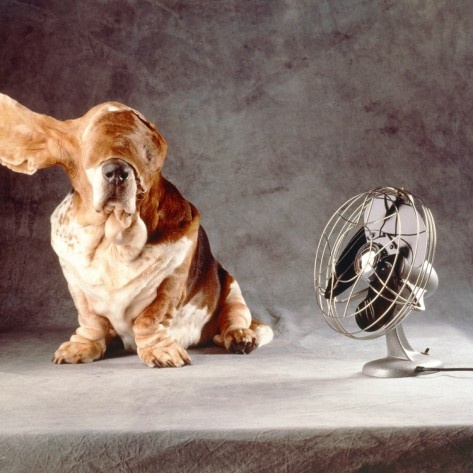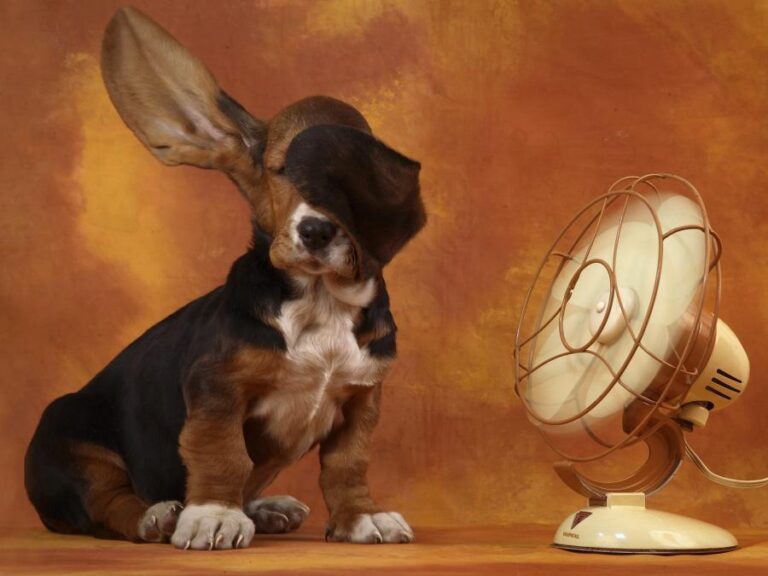Dogs’ reactions to fans at night can vary, with many being unbothered and even comforted by the white noise. The gentle hum can create a more peaceful sleeping environment, drowning out other sounds. However, it’s crucial to observe your dog’s response, as some may be uncomfortable or anxious due to the fan’s movement or noise, especially if they are not accustomed to it.
If introducing a fan, start with a low setting and monitor your dog’s behavior. Ensure the placement avoids creating drafts that could make the dog too cold. Individual preferences and tolerances differ, so it’s important to tailor the sleeping environment based on your dog’s reactions and comfort level.
What are the general responses of dogs to fans at night?

Dogs’ responses to fans at night can vary based on their individual personalities, experiences, and preferences. In general, many dogs are not bothered by fans and may even find them comforting. Here are some possible reactions:
Indifference
Some dogs may be indifferent to fans and simply ignore them. These dogs may not be affected by the sound or movement of the fan and may continue to sleep or rest as usual.
Comfort
The gentle humming sound of a fan can create white noise, which might be soothing for some dogs. This constant background noise can drown out other potentially disturbing sounds and help dogs relax.
Curiosity
Some dogs may show curiosity towards the fan, especially if it has moving blades. They might sniff or investigate the fan briefly before losing interest.
Anxiety or Fear
On the other hand, some dogs may be fearful or anxious around fans, especially if they are not accustomed to the noise or movement. In such cases, the dog might exhibit signs of stress, such as pacing, panting, or seeking reassurance from their owner.
Playfulness
Certain dogs may see the moving blades of a fan as an interesting object and may try to play with the airflow or even attempt to catch the moving blades. This behavior is not safe and should be discouraged.
It’s important to note that individual dogs may react differently, and their responses can be influenced by factors such as their past experiences, temperament, and overall health. If you’re introducing a fan into your dog’s sleeping environment, monitor their behavior to ensure they are comfortable and not exhibiting signs of distress.
How do individual variations impact dogs’ preferences for fans at night?
Individual variations among dogs can significantly impact their preferences and responses to fans at night. These variations are influenced by factors such as the dog’s personality, past experiences, breed traits, health, and overall temperament. Here’s how these factors might come into play:
Personality
Dogs, like humans, have distinct personalities. Some dogs may be more laid-back and adaptable, accepting the presence of a fan without much concern. Others may be more sensitive or cautious, potentially showing hesitation or anxiety in response to the fan.
Past Experiences
A dog’s past experiences play a crucial role in shaping their reactions to new stimuli. If a dog has had positive experiences with fans in the past, such as feeling comfortable and secure with the white noise they produce, they may be more accepting of fans at night. Conversely, a negative experience, such as a loud fan startling the dog, might make them wary.
Breed Traits
Different dog breeds exhibit various temperaments and sensitivities. For example, some breeds are known for being more adaptable and easygoing, while others may be more prone to anxiety or nervousness. Understanding breed-specific traits can give insight into how a dog might react to environmental changes, including the introduction of a fan.
Health
A dog’s health can impact their overall sensitivity to their environment. Dogs with certain health issues, such as hearing impairment or heightened anxiety, may respond differently to the presence of a fan. Additionally, older dogs or those with mobility issues may have different preferences for their sleeping environment.
Temperament
Dogs with confident and secure temperaments are generally more adaptable to changes in their surroundings. On the other hand, dogs with anxious or timid temperaments may take longer to adjust to the introduction of a fan, and they may need extra reassurance from their owners.
To cater to individual variations, it’s essential for dog owners to observe their pets closely, monitor their behavior, and respond accordingly.
Gradual introductions and positive associations with the fan, such as offering treats or praise, can help dogs become more comfortable.
How should one effectively introduce a fan to a dog’s sleeping environment?

Introducing a fan to a dog’s sleeping environment should be approached with care and consideration for the individual dog’s temperament. Start by observing your dog’s reactions to new stimuli and choose a quiet fan with a gentle hum. Initially, place the fan at a distance from your dog’s sleeping area, allowing them to become familiar with the sight and sound gradually. Use positive reinforcement, such as treats and praise, to create positive associations with the fan.
Over several days or weeks, gradually move the fan closer, monitoring your dog’s reactions at each step. If your dog shows signs of stress, move the fan back to a comfortable distance and proceed more slowly. Ensure the sleeping area remains comfortable and familiar, with familiar toys or blankets for added security. Be patient during the adjustment process, and monitor your dog’s behavior at night once the fan is fully introduced.
If concerns persist, consult with a professional dog trainer or behaviorist for personalized guidance. Every dog is unique, so tailoring the introduction to your dog’s specific preferences is essential for a positive experience.
FAQ’s
Will a fan help keep a dog cool?
Yes, a fan can help keep a dog cool by promoting air circulation and reducing ambient temperature.
How can I keep my dog cool at night?
Keep your dog cool at night by providing a well-ventilated sleeping area, using cooling pads, and ensuring access to fresh water.
What are signs of overheating in dogs?
Signs of overheating in dogs include excessive panting, drooling, lethargy, vomiting, and difficulty breathing.
How do dogs cool off?
Dogs cool off by panting, sweating through their paw pads, and seeking shade. They may also enjoy swimming or lying on cool surfaces.
How do you comfort a dog in heat?
Comfort a dog in heat by providing a quiet and cool environment, offering extra attention and gentle petting, and using cooling products like cooling mats.
Final Words
Every dog is different when it comes to fans at night. Some dogs like them because of the soothing sounds they make, while others might feel a bit uneasy. It’s essential to pay attention to your dog’s reactions and adjust accordingly. If your furry friend seems happy with the fan, that’s great!
If not, consider trying different things or letting them sleep without it. The key is to create a comfortable and peaceful sleeping environment tailored to your dog’s unique preferences.

